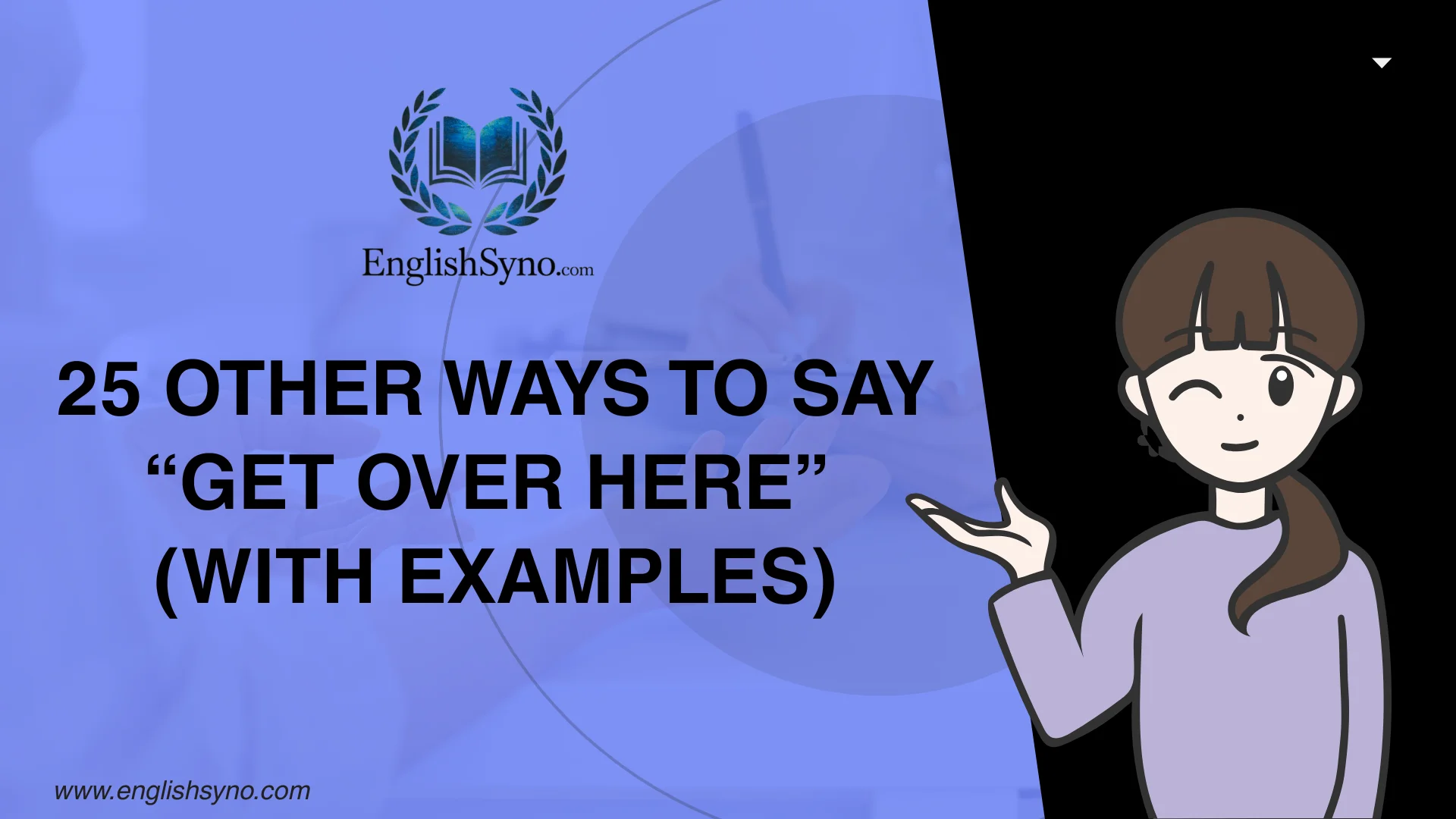The phrase “Get Over Here” goes beyond a simple command-it’s a powerful way to grab attention and create immediate engagement. Whether used in casual conversations, team settings, or playful interactions, it signals urgency while also inviting focus and participation. Its strength lies in the clarity and energy it conveys, making others respond quickly and intuitively.
Using “Get Over Here” effectively is about timing, tone, and context. When expressed with the right emphasis, it can spark curiosity, encourage collaboration, or simply draw someone closer warmly and directly. Understanding how to use this phrase and exploring its alternatives can help you communicate more dynamically, making your interactions feel intentional, engaging, and personal.
What Does “Get Over Here” Mean?
The phrase “Get Over Here” is a direct command used to ask someone to come closer or approach. In everyday communication, it can be seen as assertive, urgent, or playful depending on the tone and context. It literally indicates movement towards the speaker, but metaphorically, it can be used to encourage participation, attention, or presence.
When to Use “Get Over Here”
Use “Get Over Here” when you need someone to join you immediately, participate in an activity, or respond quickly. It is most effective in casual, familiar, or playful contexts, such as with friends or colleagues you know well.
Is It Professional/Polite to Say “Get Over Here”?
While “Get Over Here” is not inherently rude, it is generally informal. Using it in professional or formal settings may be perceived as abrupt or impolite. Opt for softer alternatives if you aim to maintain a professional tone.
Pros and Cons
Pros:
- Direct and clear
- Grabs attention immediately
- Often playful in casual contexts
Cons:
- Can sound commanding or abrupt
- May be inappropriate in professional or formal situations
- Tone can be misinterpreted if not accompanied by context or body language
Come Here
Definition & Explanation:
“Come Here” is a simple, direct request for someone to approach. Unlike “Get Over Here,” it is slightly softer and less commanding.
Example:
“Hey, could you come here for a second? I need your opinion on this document.”
Best Use: Casual or semi-formal situations; politely asking for attention.
Worst Use: Can feel weak if urgency is required.
Tone: Friendly, approachable
Join Me
Definition & Explanation:
“Join Me” emphasizes participation and inclusivity rather than just physical proximity. It conveys warmth and a sense of shared experience.
Example:
“I’m setting up the board game; join me and we can start playing together.”
Best Use: Encouraging collaboration or shared activity.
Worst Use: If physical proximity is essential, this may be too vague.
Tone: Inviting, friendly
Come Closer
Definition & Explanation:
“Come Closer” suggests moving near but can also create a sense of intimacy or privacy, depending on context.
Example:
“There’s something I want to tell you. Come closer so you can hear it.”
Best Use: Private conversations or creating closeness.
Worst Use: In public or formal settings, it may feel too intimate.
Tone: Warm, personal
Step Over
Definition & Explanation:
“Step Over” is a casual and slightly playful alternative, often used when inviting someone to a specific location or space.
Example:
“Could you step over here and help me with this setup?”
Best Use: Casual interactions, playful commands.
Worst Use: Formal settings or serious commands.
Tone: Casual, playful
Move Closer
Definition & Explanation:
“Move Closer” asks someone to physically approach, gently emphasizing proximity without sounding harsh.
Example:
“Can you move closer so you can see the details of this painting?”
Best Use: Informal or friendly settings where proximity is needed.
Worst Use: Professional settings where a softer request may be better.
Tone: Friendly, clear
Come Along
Definition & Explanation:
“Come Along” is an inviting alternative that encourages joining in an activity rather than just moving physically closer.
Example:
“We’re going to grab coffee, come along if you want to chat.”
Best Use: Casual invitations or group activities.
Worst Use: If immediate attention is needed, it may feel too relaxed.
Tone: Warm, inviting
Step Forward
Definition & Explanation:
“Step Forward” suggests moving closer while highlighting initiative or participation.
Example:
“Please step forward to share your idea with the team.”
Best Use: Group settings or encouraging engagement.
Worst Use: Can feel formal or commanding if misused.
Tone: Encouraging, assertive
Come Near
Definition & Explanation:
“Come Near” is a polite, gentle way to ask someone to approach, often conveying care or attention.
Example:
“Could you come near? I want to show you something special.”
Best Use: Private, friendly conversations.
Worst Use: Public, professional spaces where less intimacy is preferred.
Tone: Warm, considerate
Step Over Here
Definition & Explanation:
“Step Over Here” is casual, often playful, and signals movement toward a specific spot.
Example:
“Hey, can you step over here and see this cool gadget?”
Best Use: Informal, fun interactions.
Worst Use: Professional or urgent contexts.
Tone: Playful, casual
Swing By
Definition & Explanation:
“Swing By” encourages someone to visit or join in, often temporarily or casually.
Example:
“Feel free to swing by my office if you have questions.”
Best Use: Friendly visits or casual collaboration.
Worst Use: Formal requests needing urgency.
Tone: Relaxed, inviting
Drop In
Definition & Explanation:
“Drop In” implies coming over casually, often without a formal invitation.
Example:
“You should drop in later, we’ll have snacks ready.”
Best Use: Casual home or social settings.
Worst Use: Professional, structured environments.
Tone: Friendly, informal
Come Over
Definition & Explanation:
“Come Over” invites someone to your location, highlighting friendliness and warmth.
Example:
“Why don’t you come over tonight? We can watch the game.”
Best Use: Social or informal situations.
Worst Use: Formal or business contexts.
Tone: Warm, inviting
Approach Me
Definition & Explanation:
“Approach Me” is slightly more formal, emphasizing intentional movement toward the speaker.
Example:
“If you have questions, please approach me after the presentation.”
Best Use: Semi-formal settings; encouraging communication.
Worst Use: Casual, playful contexts.
Tone: Professional, polite
Step This Way
Definition & Explanation:
“Step This Way” gently guides someone toward a particular location, often used in hospitality or tours.
Example:
“Step this way, I’ll show you to your seat.”
Best Use: Guiding someone politely in a physical space.
Worst Use: Urgent situations needing faster movement.
Tone: Polite, guiding
Come Join
Definition & Explanation:
“Come Join” emphasizes inclusion and shared activity rather than just proximity.
Example:
“We’re playing cards; come join us for a round.”
Best Use: Group activities or social events.
Worst Use: One-on-one urgent requests.
Tone: Inviting, inclusive
Move Over
Definition & Explanation:
“Move Over” directs someone to shift closer or make space, often casually.
Example:
“Could you move over so I can sit next to you?”
Best Use: Casual seating arrangements.
Worst Use: Formal or professional meetings.
Tone: Informal, friendly
Come Alongside
Definition & Explanation:
“Come Alongside” emphasizes joining in support or participation, rather than just approaching physically.
Example:
“I’m handling the decorations; come alongside if you want to help.”
Best Use: Collaborative settings, teamwork.
Worst Use: Urgent commands.
Tone: Encouraging, supportive
Move This Way
Definition & Explanation:
“Move This Way” is a direct but polite guide toward a specific direction or spot.
Example:
“Please move this way, the setup is right there.”
Best Use: Guiding people in spaces, casual or semi-formal.
Worst Use: Overly forceful or playful settings.
Tone: Polite, clear
Come Close
Definition & Explanation:
“Come Close” is gentle and intimate, often used to share something private or important.
Example:
“Can you come close? I want to tell you a secret.”
Best Use: Private or intimate situations.
Worst Use: Public spaces where closeness may be uncomfortable.
Tone: Warm, personal
Step Right Up
Definition & Explanation:
“Step Right Up” is playful and inviting, often used to draw attention or participation.
Example:
“Step right up and try your luck at the game!”
Best Use: Fun, playful interactions or events.
Worst Use: Serious or formal contexts.
Tone: Playful, energetic
Join In
Definition & Explanation:
“Join In” invites someone to participate in an ongoing activity or discussion.
Example:
“We’re brainstorming ideas; join in if you have suggestions.”
Best Use: Group activities, collaborative work.
Worst Use: When physical proximity is required urgently.
Tone: Inclusive, friendly
Come Over Here
Definition & Explanation:
“Come Over Here” is slightly more formal than “Get Over Here”, maintaining friendliness while requesting proximity.
Example:
“Could you come over here and check this document with me?”
Best Use: Friendly, polite requests for someone to move closer.
Worst Use: Casual or playful contexts may feel rigid.
Tone: Polite, clear
Move Closer Here
Definition & Explanation:
“Move Closer Here” emphasizes immediate proximity with gentle instruction.
Example:
“Please move closer here to see the details on the map.”
Best Use: Educational or demonstration settings.
Worst Use: Casual conversations where tone should be softer.
Tone: Direct, polite
Come Over and See
Definition & Explanation:
“Come Over and See” invites someone to join and observe, often creating curiosity or shared experience.
Example:
“You should come over and see this amazing painting I found.”
Best Use: Social invitations or sharing something interesting.
Worst Use: Urgent situations; may be too slow or casual.
Tone: Friendly, inviting
Step Closer
Definition & Explanation:
“Step Closer” is a polite request for someone to reduce distance, emphasizing care or intimacy.
Example:
“Could you step closer so I can hear you clearly?”
Best Use: Private conversations or careful guidance.
Worst Use: In large group settings where clarity is needed from afar.
Tone: Warm, considerate
Final Thoughts
Expressing yourself clearly and thoughtfully is a vital part of meaningful communication, and finding alternatives to “Get Over Here” can make a significant difference in how your message is received. Using more empathetic, playful, or polite alternatives not only softens the tone but also strengthens your connection with others. Words have power-they can convey urgency, warmth, or friendliness depending on the phrasing, context, and delivery.
When you choose phrases like “Come Closer,” “Join Me,” or “Step Over Here,” you invite others to participate, engage, or pay attention without sounding abrupt or commanding. This approach is particularly helpful in social interactions, casual teamwork, or friendly settings, where tone matters more than authority. Even in professional environments, carefully selected alternatives can maintain clarity while remaining courteous and considerate.
It’s essential to understand the context, relationship, and tone before deciding which alternative to use. For example, “Step Right Up” works well in playful or engaging settings, while “Approach Me” fits semi-formal or structured conversations. Each alternative carries subtle nuances that shape the listener’s perception and reaction.
By thoughtfully selecting the right phrase, you can make instructions, invitations, or requests feel personal, warm, and engaging, enhancing communication and improving relationships. Whether you’re guiding someone physically, inviting participation, or drawing attention, these alternatives ensure your words resonate, leaving a positive impression and fostering meaningful interaction.
FAQs
What does “Get Over Here” mean?
It is a direct command asking someone to come closer. Depending on context, it can be playful, urgent, or assertive.
Is “Get Over Here” polite?
Generally informal. Tone matters: it’s friendly among peers but may feel abrupt in professional settings.
Can I use it professionally?
Use softer alternatives like “Approach Me” for professional contexts to maintain courtesy and clarity.
When is “Come Closer” best used?
Private conversations or intimate settings where you want to create closeness and attentiveness.
How does “Join Me” differ?
It focuses on inclusion and shared activity rather than physical proximity, making it warm and inviting.
What is a playful alternative?
“Step Right Up” or “Swing By” conveys fun and casual engagement without pressure.
Which phrases suit teamwork?
“Come Alongside” or “Join In” encourages collaboration and participation.
How to make commands softer?
Use polite verbs like “come,” “step,” or “move” with a friendly tone for clarity without abruptness.
Are all alternatives suitable for friends?
Yes, most are casual and friendly; select based on context and relationship.
Can these phrases indicate urgency?
Yes, words like “Step Closer” or “Move Closer Here” convey prompt action while remaining polite.
How do tone and context affect meaning?
Tone, body language, and setting change perception; the same phrase can be playful, serious, or intimate.
Is “Come Over and See” formal?
No, it’s casual, ideal for sharing experiences, not formal commands.
What are best uses for “Step This Way”?
Guiding people politely in physical spaces, often in hospitality or tours.
Can these alternatives improve relationships?
Yes, they make communication feel considerate, inclusive, and engaging.
Are all alternatives suitable online?
Many work digitally for invitations, instructions, or casual engagement, but adjust for tone and clarity.



